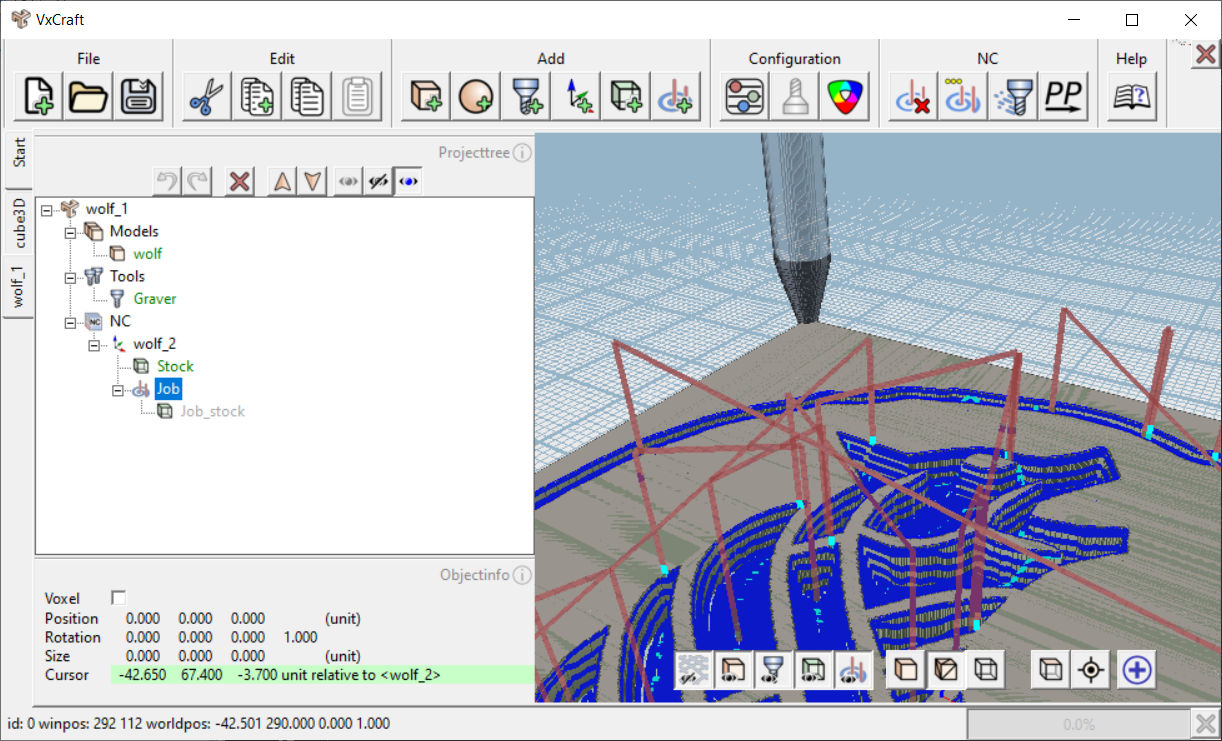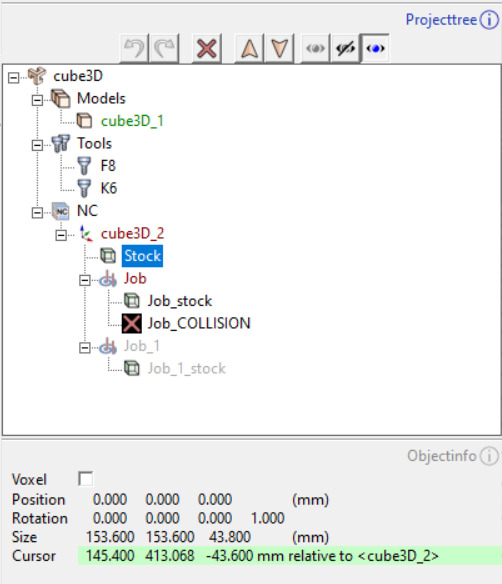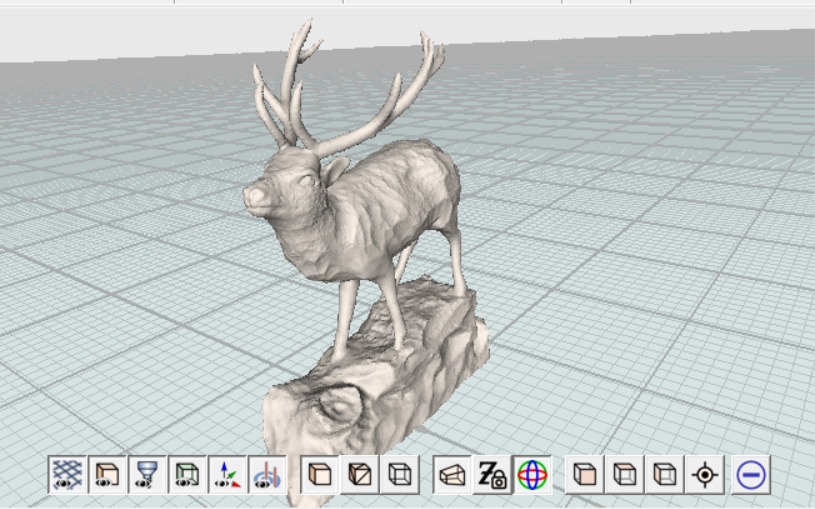Main window
The main window of VxCraft is the central workspace of the application, where all important functions and tools are provided. It includes the rendering window for displaying 3D objects and scenes, the menu bar for accessing main functions, project tabs of the opened projects, the project tree for organizing objects and layers, and the object info box that displays information about selected objects.
 © vxcraft.com
© vxcraft.com
Main menu
The main window has a menu at the top that provides access to the various functions and settings of the program. It is divided into logically structured sections. Each category in the menu has a title and the most important functions as icons for quick access. Clicking on the category name opens a popup menu containing all the functions of that category.
 © vxcraft.com
© vxcraft.com
Menu category "File"
This menu group contains the file management for input and output, as well as the general control of the program.
New
Creates a new project and starts with an empty working environment.
Open
Opens an existing project or template.
Save
Saves the current state of the open project or template.
Save as
Saves the currently opened project or template under a new file name.
Close project
Closes the currently opened project.
Close
Asks whether the opened projects should be saved and exits VxCraft.
Menu category "Edit"
This menu group contains general functions for selected objects.
Cut
Removes the selected objects from the project tree and copies them to the clipboard.
Duplicate
Creates a copy of the selected objects.
Copy
Copies the selected objects to the clipboard. The child objects, unless also selected, are not copied.
Paste
Pastes the objects from the clipboard into the project.
Remove
Removes the selected objects from the project.
Remove all references
Deletes all connections of the selected objects to other objects. Useful when inserting objects from another project.
Menu category "Add"
This menu group contains functions for creating and importing new objects.
Add heightmap
Adds an empty heightmap object. To create the geometry, various options are available in the configuration dialog, which opens automatically after creation.
Add 3D model
Adds an empty 3D model object. To create the geometry, various options are available in the configuration dialog, which opens automatically after creation.
Add tool
Adds an empty tool object or loads one from a template. The geometry is defined using the tool editor, which opens automatically after an empty tool is created.
Add NC-Pack
Adds an empty NC-Pack object or loads one from a template. An NC-Pack defines the zero point for the jobs it contains. The zero point can be set in the configuration dialog, which opens automatically after an empty object is created.
Add stock
Adds an empty stock object. To create the geometry, various options are available in the configuration dialog, which opens automatically after creation.
Add job
Adds an empty job object or loads one from a template. Contains all parameters for calculating a toolpath. The parameters can be defined in the configuration dialog, which opens automatically after creation.
Menu category "Configuration"
This menu group contains functions for configuring selected objects and the color palette.
Configuration object
Opens the corresponding configuration dialog for the selected object, depending on the object type.
Tool editor
Opens the tool editor for the selected tool to edit or define the geometry.
Colors
Opens the dialog with the color palette for creating and changing colors.
License manager
Opens a dialog window for managing the purchased license. The license manager displays the current license status and can be used to load or remove a purchased license.
System settings
Opens a dialog window for adjusting the system settings. Once this window is closed, all changes made are automatically saved. Some settings require a restart of the program for the changes to take effect. For more information see the chapter "Lua module settings/settings.lua".
Menu category "NC"
The NC menu group contains functions for managing the toolpaths
Reset toolpath
Deletes the calculated toolpath. The job object itself is retained.
Calculate tool path
Deletes the existing toolpath if necessary and calculates the job object. Creates a toolpath if successful.
Solid Live Simulation
Starts the environment "VxCraft - Solid Live Simulation". This can be used to simulate the selected toolpaths.
Postprocessor
Starts the postprocessor environment
Menu category "Help"
The Help menu group contains functions for displaying documentation and information about VxCraft.
Open user manual
Opens the table of contents of the user manual. You can choose between the online version and the local version.
Program files
Opens the folder in Explorer where VxCraft stores temporary data, settings files, templates, sample projects and postprocessors.
Update
Opens the VxCraft information dialog, which contains a link for checking for available updates.
About VxCraft
Displays basic information about VxCraft.
Project tab
In the main window, vertically arranged tabs can be found on the left side for each open project. By clicking on one of these tabs, the active project can be changed.
 © vxcraft.com
© vxcraft.com
Project tree
The project tree is a central element in VxCraft's workflow and displays the structure of the entire project. The context menu opens by right-clicking on one or more selected objects, dynamically adapts to the selection and offers almost all the functions of the main menu.
Object types and structure
This section gives an overview of the object types and the tree structure of a project.
The project tree is hierarchical and has a fixed structure. The topmost object is the project element and bears the name of the saved project file. The project element contains all other objects.
Fixed folders
Each project has fixed folders from the beginning:
| Folder | Description |
|---|---|
| Models | Includes all heightmaps and models of the project |
| Tools | Includes all tools of the project |
| NC | Contains all NC-Packs of the project |
Creatable objects
The following table lists all the objects that can be created:| Object | Parent element | Short description |
|---|---|---|
| Heightmap | Models | A 3D geometry generated from 2D data |
| 3D-Models | Models | A 3D geometry consisting of facets |
| Tool | Tools | Contains the cutting and shank geometry of an NC tool, as well as tool-relevant parameters. |
| NC-Pack | NC | Determines the NC-Zero Point for the containing jobs |
| Stock | NC-Pack | A heightmap that specifies the geometry of the starting material (blank) for the calculation. |
| Job | NC-Pack | A job object contains all references and parameters for the toolpath calculation. |
Generated objects
The following table lists all automatically generated objects:| Object | Parent element | Short description |
|---|---|---|
| Resulting stock | Job | Is calculated and generated from the tool and stock reference of the job and the toolpath. Can be used as a stock reference for subsequent jobs. |
| Collision evaluation | Job | This optional object is created when a collision is detected during the toolpath calculation. It displays the collision points. |
Text color
The text color of the elements in the project tree gives conclusions about the state and properties.| Text color | Description |
|---|---|
| blue | The object is referenced by a selected object. |
| red | The object references a selected object. |
| Faded color | The object is hidden. |
References
References are links between objects in the project tree. An object can read the data and properties of the reference, but cannot change them. To prevent reference loops, some reference types only allow references that are above the object in the hierarchy.
Object name
The name of the object may occur only once in the project. If the name is already assigned, a consecutive number is appended to the name.
Project tree functions
Undo
Undoes the last change to the hierarchy.
Redo
Restores the previous change to the hierarchy.
Remove
Removes the selected objects from the project.
Up
Moves the selected object up in the hierarchy.
Down
Moves the selected object down in the hierarchy.
Show
Displays the selected objects. In order for the object to actually be shown in the render window, it must also be ensured that the corresponding layer is shown in the render window toolbar. The <> key can be used to toggle the visibility of an object.
Hide
Hides the selected objects. An object remains hidden even if the corresponding layer of the object type is shown in the Render Window toolbar. The <> key toggles the visibility of an object.
Automatically show and hide jobs
When this mode is activated, selected jobs are automatically faded in. Jobs that are not selected are automatically hidden.
Render window
The render window is the central visualization element in VxCraft. It shows the 3D rendering of the objects contained in the project tree and allows interaction and navigation in the scene.
 © vxcraft.com
© vxcraft.com
Workplane
 © vxcraft.com
© vxcraft.com
Absolute zero point
The absolute zero point is represented as a coordinate system and is the origin of the project scene. It determines the three main axes X, Y and Z. The camera control and the working grid are oriented to this zero point.
Work grid
The work grid in the render view is located on the Z-plane of the absolute zero point. The size of the work grid can be used as a guideline for the maximum size of the models. It dynamically adapts to the project resolution and is based on the following scales:
| Grid | Rendering | Scale | Comment |
|---|---|---|---|
| Voxel | fine lines | 1 Voxel | Offset by half a voxel to absolute zero. |
| Unit | standard lines | 1 User unit | Represents the distance 1 voxel x project resolution |
| Unit big | bold lines | 10 User units | Represents the 10-fold distance of a unit. The factor can be changed in the settings. |
Toolbar
The toolbar is located at the bottom of the render window and provides functions to control rendering and camera control. On the far right of the toolbar is a blue plus sign in a circle. When the plus is activated, the toolbar expands to include several additional functions. All functions are listed below, with the extra functions marked with a (+).
Layer group
The "Layer" symbol group controls the visibility of individual object groups. Regardless of the layer status, objects always remain hidden if they are hidden in the project tree (see also Project tree functions).
| Layer | Description |
|---|---|
| Workplane | Hides/shows the grid of the workplane and the coordinate system of the absolute zero point |
| Model | Shows/hides heightmaps and 3D models |
| Tool | Hides/shows tools |
| Stock | Fades stock in/out |
| (+) NC-Pack | Shows/hides the coordinate systems of the NC-Zero Points |
| Job | Hides/shows jobs |
Group rendering
Controls the general rendering mode of the objects.
| Rendering | Description |
|---|---|
| Solid | Shows the objects as solid surfaces |
| Solid+Wire model | Shows the objects as solid surfaces with visible wireframe over them |
| Wire model | Shows the objects in wireframe mode |
Group camera
Controls the behavior of the camera and the projection mode. The key assignment for the camera control is described in the chapter Shortcuts.
| Function | Description |
|---|---|
| (+) Projection mode | Switches between perspective and orthogonal projection |
| (+) Z-Lock | Disables moving the camera target point in direction Z. "3D Rotation" is automatically disabled. |
| (+) 3D-Rotation | The camera allows rotation around two axes. By activating the 3D rotation mode, the camera control is extended so that rotation around all three axes is possible. "Z-Lock" is automatically deactivated. |
Group view
Sets the camera to a specific orientation.
| View | Description |
|---|---|
| (+) Front | Shows the scene from the front. Right click to show the scene from behind |
| Top | Shows the scene from above. Right click to show the scene from below |
| (+) Right | Shows the right side of the scene. Right-click to show the left side of the scene |
| Reset | Resets the camera to the original orientation |
Additional functions
Shows and hides additional functions in the toolbar.
Object info
The object info area shows information about selected objects, such as position, rotation, size and cursor coordinates.
 © vxcraft.com
© vxcraft.com
Unit Voxel
With the help of this checkbox, the values displayed in the object info box can be changed to the unit "voxel".
Position
The position information gives the coordinates of the selected object with respect to the global origin.
Rotation
The rotation information shows the rotation values of the selected object as a quaternion with respect to the global origin.
Size
The size values reflect the local size of the selected object.
Cursor
The cursor coordinates indicate the 3D position of the mouse in the render window. The origin for the position determination depends on the selected object selection.
By default, the coordinates have a white background and show the values based on the global origin. However, if only one object is selected and this object is of type NC-Pack or the object is located in an NC-Pack, the coordinates are displayed based on the NC-Zero Point. In this case, the coordinates are highlighted in light green.
